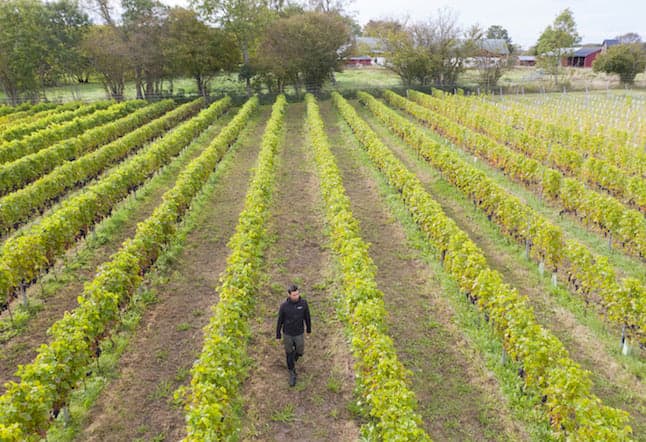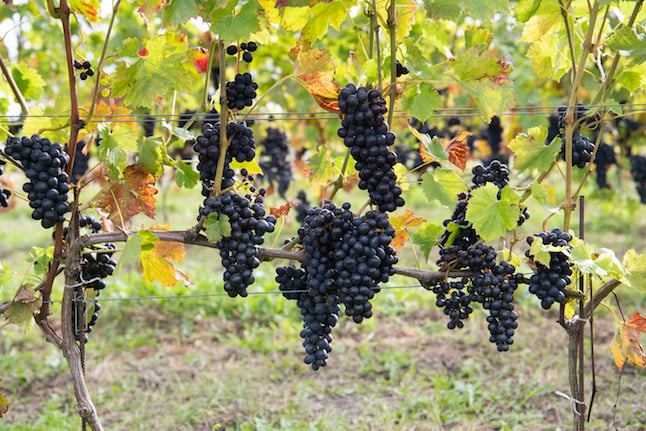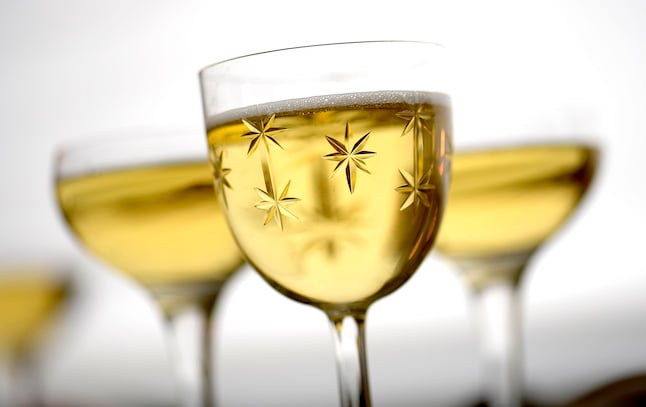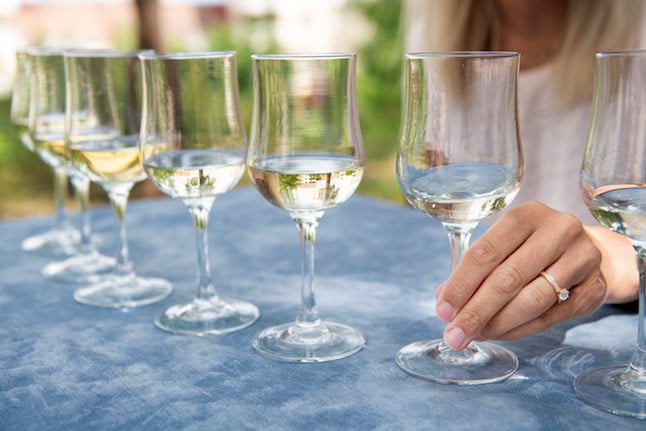How Sweden became the unlikely home of a booming wine-growing industry

Sweden may not be known for its wine, but it now boasts around 40 commercial vineyards. Do farmers manage to earn a living, can climate change benefit their business, and does the wine actually taste good? Anne Grietje Franssen investigates.
It's a sunny afternoon in September and farmer Niclas Albinsson is hidden from view among his vines. He sits on a chair on wheels and he has scissors at the ready, cutting off bunches of grapes – there are just under twenty per vine.
Albinsson then removes the grapes that are damaged or rotten, places the bunches in a container and rolls on to the next plant with his two dogs in tow. His wife Anna sits a row away and performs the same, methodical actions.
This is not the French Loire. We’re at the Särtshöga vineyard in the town of Väderstad, a few kilometers from Lake Vättern in southern Sweden.
“Once we’ve collected 150 kilos, we go inside to press the wine. That's what we get done within a day: one pick and one pressing," Albinsson explains. He and his wife have a second vineyard, but they won’t be able to harvest there for another week or two. Which is a good thing: if all the grapes would ripen around the same time, there would be more work than they could manage between the two.
Albinsson: “The moment at which we can harvest is very specific. First we have to measure the sugar content by picking ten grapes in every second row and pressing them manually. The level we are looking for is 170 grams of sugar per liter. If the sugar content is 165 grams and the forecast predicts sunny weather, we should be able to harvest four or five days later.”

A vineyard on Gotland. Photo: Fredrik Sandberg/TT
Särtshöga Vingård is one of about forty commercial vineyards in Sweden, in addition to about 150 hobbyists. Most winegrowers, such as the Albinssons, have an area of two to three hectares. The total surface area of Swedish wine grape cultivation covers between 100 and 150 hectares of land.
Not bad for a sector that only emerged about 20 years ago.
“Viticulture is developing rapidly,” says Sveneric Svensson, spokesperson for Föreningen Svenskt Vin, the trade association for Swedish winegrowers. “Interest among Swedes is huge; every year we can add a few new vineyards to the list.” The newly established Swedish Trade Organisation for Oenology & Viticulture (SBOV) believes there is still plenty of room for expansion – not least because of the changing climate. After all, grapes need warmth to ripen, and warmth isn’t always readily available in Sweden.
Viticulture, the cultivation and harvesting of grapes, came to the north in the late 1990s after the emergence of a number of new grape varieties in Freiburg, Germany. The grapes, especially the Solaris and Rondo, proved to be able to withstand the cool climates of places like the United Kingdom, Denmark and northern Germany – as well as certain areas of Sweden.
Svensson: “A couple of pioneers started with a few vines and showed that it was possible: the grapes survived and ripened.” Those new species also proved resilient. “Whatever the weather, Swedish winegrowers have been able to harvest every year thus far.”
The most common type of wine made in Sweden is white. “The average type of Swedish wine is one that somewhat resembles a sauvignon blanc. It is aromatic, with a lemony scent and a fresh, fruity taste," says Svensson.
Another style that is becoming increasingly popular among Swedish grape farmers is sparkling wine. Svensson: "It's not the same grape as the one in Champagne, but the taste is similar." Is it worth trying? “The quality keeps getting better,” he asserts. “Our wines regularly win international prizes.”

Wine glasses. Photo: Janerik Henriksson/TT
Albinsson is a farmer who focuses exclusively on sparkling wines which he says he produces according to "traditional methods". His own tradition of viticulture, though, is barely a decade old: Niclas and Anna Albinsson bought this farm in 2012. They were, they say, the first wine producers at Lake Vättern. Most of the viticulture takes place in Skåne, on the south-west coast of Sweden, where summers are relatively warm and winters mild.
Grapes also seem to grow well in the Blekinge region on the south-eastern coast. Here, near the town of Karlskrona, lies the Stora Boråkra vineyard of farmer Staffan Ottosson. His interest in wine was sparked after reading an article in 2008 which reported that much of southern Europe was becoming too warm to produce good wine and that the demand for grapes from northern Europe was increasing.
The newspaper article included a map showing the areas where the Solaris and Rondo in Sweden thrive: from Gothenburg in western Sweden via Oskarshamn to Öland and the island of Gotland in the Baltic Sea.
It just so happened that he lived on a farm in the very area designated as suitable for Swedish viticulture. “I visited some of the vineyards mentioned in the article and thought, you know what? Let’s put 300 vines in the ground.”
Most old farms around Karlskrona have a vegetable garden. Ottosson and his wife also owned a fertile plot of land on a south slope. That's where they planned to grow the grapes. “Well, sooner or later you have a harvest and then you need to extract some sort of liquid from that harvest. I used my feet and a potato masher and put the result in a glass jar. It turned out to be a very bad wine. Growing grapes is one thing; making wine is a profession in its own right.”
Ottosson and his wife began to delve into the business of grape growing and wine production. “We got to a point where it was no longer something we could do on the side. The workload become too much. I quit my engineering job in the city and started working full-time on the farm. Today we have 4,000 vines.”
About 99 percent of their grapes are Solaris, from which they make white and sparkling wine, without added sugar. They ferment the rest of the pressing, turning it in a kind of grappa, even though they’re not allowed to label it by that name.
Their sale of wine, however, is only one source of income, as is the case for many Swedish winegrowers. At most vineyards, the menu offers also tastings and tours of the premises. “Visitors are an important part of our economy,” Ottosson explains.
The same goes for the Albinssons, who were inspired by "agriturismo" in Tuscany – a combination of agriculture and tourism – and who run a bed and breakfast and a restaurant besides their viticulture. All of these different activities ultimately revolve around their product, which is wine, but it is thanks to the other services that they earn a decent living. “We have three legs to stand on: food, drink and accommodation.”

A wine tasting. Photo: Jessica Gow/TT
The reason that many Swedish winegrowers offer these type of services is closely related to the hot topic of gårdsförsäljning, literally "farm sale": the characteristic cellar door at a winery where, in countries like France, bottles and boxes of wine are sold without intermediary.
In Sweden these cellar door shops are out of the question; the state has a monopoly on alcohol sales. Winegrowers can only sell their wine at Systembolaget, the government-owned chain of liquor stores in Sweden, which will then sell it on. But most tourists and other visitors who have had a wine tasting and would like to take a few bottles home afterwards, won’t bother going to a state shop in the nearest town and looking for that specific Swedish wine. Winegrowers therefore miss out on a significant source of income.
“The issue is now being investigated at government level,” says Svensson, the spokesperson at the trade association. “They are trying to figure out if there is a way that winegrowers could sell a limited amount of wine at the door, without threatening the retail monopoly. The decision will be made next year. It's incredibly exciting. For many farmers, solving this problem would make all the difference.”
What about climate change? Is this worldwide calamity indeed something that might benefit Swedish winegrowers?
“I hope we can avert climate change as best we can,” says farmer Ottosson. "It's a massive global disaster." Yet he admits, nevertheless, that a somewhat warmer climate might benefit the cultivation of grapes in Sweden. “Though it is certainly not the climate crisis that makes viticulture in Sweden possible. The single most important development has been that we now have vines that survive in colder climates. If we hadn't had the Solaris, Swedish vineyards would never have been successful.”
Yet during that same week in late summer it also became painfully obvious how a crisis elsewhere can be a blessing here. The TV weatherman had said the warm air in the high atmosphere would give Sweden a pleasant, mild September. Ottosson: “If it's 20C in September, that's great for our grapes. But that same weather phenomenon is causing storm Ida in another part of the world.”

Winegrower Staffan Lake in Skåne (not featured in the article). Photo: Björn Lindgren/TT
Farmer Albinsson does not believe that a warmer climate contributes to or improves Swedish viticulture. “Extreme weather is also becoming more and more common. We will have to prepare ourselves for excessive rainstorms and sudden droughts.”
“I think that we will be able to continue developing Swedish viticulture,” Albinsson continues, “but in order to do so everybody will have to take their responsibility. We try to do our bit by preventing depletion of the land. We grow our grapes organically and according to the principles of 'regenerative agriculture’, which means, in practice, that we plant ground covers between the rows of vines to keep the soil healthy while simultaneously retaining carbon. Also, because we have those ground covers, we don’t need heavy machinery or pesticides to remove weeds.”
Svensson, from the trade association for Swedish winegrowers, confirms that almost all Swedish wine is made organically, even if not everyone has the official certification. “These grapes are very resistant to diseases and fungi and don't really need pesticides. Viticulture in Sweden is generally very sustainable: we produce low volumes at high prices.”
So both winegrowers doggedly carry on with what they are doing. Ottosson: “I can say that this is the most intensive period of my life. I have never worked so hard and earned so little.” He smiles. “My wife regularly accuses me of working too much. To which I react: I am just playing outside! As soon as work starts to feel like an obligation, you have to stop.”
Comments
See Also
It's a sunny afternoon in September and farmer Niclas Albinsson is hidden from view among his vines. He sits on a chair on wheels and he has scissors at the ready, cutting off bunches of grapes – there are just under twenty per vine.
Albinsson then removes the grapes that are damaged or rotten, places the bunches in a container and rolls on to the next plant with his two dogs in tow. His wife Anna sits a row away and performs the same, methodical actions.
This is not the French Loire. We’re at the Särtshöga vineyard in the town of Väderstad, a few kilometers from Lake Vättern in southern Sweden.
“Once we’ve collected 150 kilos, we go inside to press the wine. That's what we get done within a day: one pick and one pressing," Albinsson explains. He and his wife have a second vineyard, but they won’t be able to harvest there for another week or two. Which is a good thing: if all the grapes would ripen around the same time, there would be more work than they could manage between the two.
Albinsson: “The moment at which we can harvest is very specific. First we have to measure the sugar content by picking ten grapes in every second row and pressing them manually. The level we are looking for is 170 grams of sugar per liter. If the sugar content is 165 grams and the forecast predicts sunny weather, we should be able to harvest four or five days later.”

A vineyard on Gotland. Photo: Fredrik Sandberg/TT
Särtshöga Vingård is one of about forty commercial vineyards in Sweden, in addition to about 150 hobbyists. Most winegrowers, such as the Albinssons, have an area of two to three hectares. The total surface area of Swedish wine grape cultivation covers between 100 and 150 hectares of land.
Not bad for a sector that only emerged about 20 years ago.
“Viticulture is developing rapidly,” says Sveneric Svensson, spokesperson for Föreningen Svenskt Vin, the trade association for Swedish winegrowers. “Interest among Swedes is huge; every year we can add a few new vineyards to the list.” The newly established Swedish Trade Organisation for Oenology & Viticulture (SBOV) believes there is still plenty of room for expansion – not least because of the changing climate. After all, grapes need warmth to ripen, and warmth isn’t always readily available in Sweden.
Viticulture, the cultivation and harvesting of grapes, came to the north in the late 1990s after the emergence of a number of new grape varieties in Freiburg, Germany. The grapes, especially the Solaris and Rondo, proved to be able to withstand the cool climates of places like the United Kingdom, Denmark and northern Germany – as well as certain areas of Sweden.
Svensson: “A couple of pioneers started with a few vines and showed that it was possible: the grapes survived and ripened.” Those new species also proved resilient. “Whatever the weather, Swedish winegrowers have been able to harvest every year thus far.”
The most common type of wine made in Sweden is white. “The average type of Swedish wine is one that somewhat resembles a sauvignon blanc. It is aromatic, with a lemony scent and a fresh, fruity taste," says Svensson.
Another style that is becoming increasingly popular among Swedish grape farmers is sparkling wine. Svensson: "It's not the same grape as the one in Champagne, but the taste is similar." Is it worth trying? “The quality keeps getting better,” he asserts. “Our wines regularly win international prizes.”

Wine glasses. Photo: Janerik Henriksson/TT
Albinsson is a farmer who focuses exclusively on sparkling wines which he says he produces according to "traditional methods". His own tradition of viticulture, though, is barely a decade old: Niclas and Anna Albinsson bought this farm in 2012. They were, they say, the first wine producers at Lake Vättern. Most of the viticulture takes place in Skåne, on the south-west coast of Sweden, where summers are relatively warm and winters mild.
Grapes also seem to grow well in the Blekinge region on the south-eastern coast. Here, near the town of Karlskrona, lies the Stora Boråkra vineyard of farmer Staffan Ottosson. His interest in wine was sparked after reading an article in 2008 which reported that much of southern Europe was becoming too warm to produce good wine and that the demand for grapes from northern Europe was increasing.
The newspaper article included a map showing the areas where the Solaris and Rondo in Sweden thrive: from Gothenburg in western Sweden via Oskarshamn to Öland and the island of Gotland in the Baltic Sea.
It just so happened that he lived on a farm in the very area designated as suitable for Swedish viticulture. “I visited some of the vineyards mentioned in the article and thought, you know what? Let’s put 300 vines in the ground.”
Most old farms around Karlskrona have a vegetable garden. Ottosson and his wife also owned a fertile plot of land on a south slope. That's where they planned to grow the grapes. “Well, sooner or later you have a harvest and then you need to extract some sort of liquid from that harvest. I used my feet and a potato masher and put the result in a glass jar. It turned out to be a very bad wine. Growing grapes is one thing; making wine is a profession in its own right.”
Ottosson and his wife began to delve into the business of grape growing and wine production. “We got to a point where it was no longer something we could do on the side. The workload become too much. I quit my engineering job in the city and started working full-time on the farm. Today we have 4,000 vines.”
About 99 percent of their grapes are Solaris, from which they make white and sparkling wine, without added sugar. They ferment the rest of the pressing, turning it in a kind of grappa, even though they’re not allowed to label it by that name.
Their sale of wine, however, is only one source of income, as is the case for many Swedish winegrowers. At most vineyards, the menu offers also tastings and tours of the premises. “Visitors are an important part of our economy,” Ottosson explains.
The same goes for the Albinssons, who were inspired by "agriturismo" in Tuscany – a combination of agriculture and tourism – and who run a bed and breakfast and a restaurant besides their viticulture. All of these different activities ultimately revolve around their product, which is wine, but it is thanks to the other services that they earn a decent living. “We have three legs to stand on: food, drink and accommodation.”

The reason that many Swedish winegrowers offer these type of services is closely related to the hot topic of gårdsförsäljning, literally "farm sale": the characteristic cellar door at a winery where, in countries like France, bottles and boxes of wine are sold without intermediary.
In Sweden these cellar door shops are out of the question; the state has a monopoly on alcohol sales. Winegrowers can only sell their wine at Systembolaget, the government-owned chain of liquor stores in Sweden, which will then sell it on. But most tourists and other visitors who have had a wine tasting and would like to take a few bottles home afterwards, won’t bother going to a state shop in the nearest town and looking for that specific Swedish wine. Winegrowers therefore miss out on a significant source of income.
“The issue is now being investigated at government level,” says Svensson, the spokesperson at the trade association. “They are trying to figure out if there is a way that winegrowers could sell a limited amount of wine at the door, without threatening the retail monopoly. The decision will be made next year. It's incredibly exciting. For many farmers, solving this problem would make all the difference.”
What about climate change? Is this worldwide calamity indeed something that might benefit Swedish winegrowers?
“I hope we can avert climate change as best we can,” says farmer Ottosson. "It's a massive global disaster." Yet he admits, nevertheless, that a somewhat warmer climate might benefit the cultivation of grapes in Sweden. “Though it is certainly not the climate crisis that makes viticulture in Sweden possible. The single most important development has been that we now have vines that survive in colder climates. If we hadn't had the Solaris, Swedish vineyards would never have been successful.”
Yet during that same week in late summer it also became painfully obvious how a crisis elsewhere can be a blessing here. The TV weatherman had said the warm air in the high atmosphere would give Sweden a pleasant, mild September. Ottosson: “If it's 20C in September, that's great for our grapes. But that same weather phenomenon is causing storm Ida in another part of the world.”

Farmer Albinsson does not believe that a warmer climate contributes to or improves Swedish viticulture. “Extreme weather is also becoming more and more common. We will have to prepare ourselves for excessive rainstorms and sudden droughts.”
“I think that we will be able to continue developing Swedish viticulture,” Albinsson continues, “but in order to do so everybody will have to take their responsibility. We try to do our bit by preventing depletion of the land. We grow our grapes organically and according to the principles of 'regenerative agriculture’, which means, in practice, that we plant ground covers between the rows of vines to keep the soil healthy while simultaneously retaining carbon. Also, because we have those ground covers, we don’t need heavy machinery or pesticides to remove weeds.”
Svensson, from the trade association for Swedish winegrowers, confirms that almost all Swedish wine is made organically, even if not everyone has the official certification. “These grapes are very resistant to diseases and fungi and don't really need pesticides. Viticulture in Sweden is generally very sustainable: we produce low volumes at high prices.”
So both winegrowers doggedly carry on with what they are doing. Ottosson: “I can say that this is the most intensive period of my life. I have never worked so hard and earned so little.” He smiles. “My wife regularly accuses me of working too much. To which I react: I am just playing outside! As soon as work starts to feel like an obligation, you have to stop.”
Join the conversation in our comments section below. Share your own views and experience and if you have a question or suggestion for our journalists then email us at [email protected].
Please keep comments civil, constructive and on topic – and make sure to read our terms of use before getting involved.
Please log in here to leave a comment.